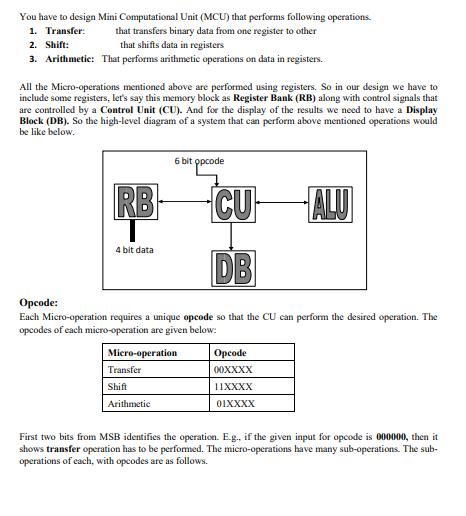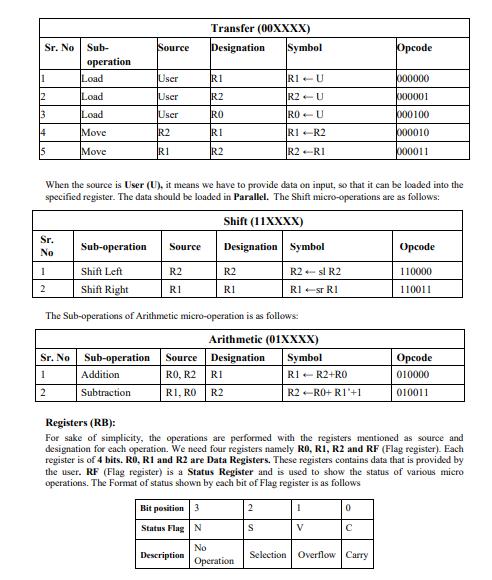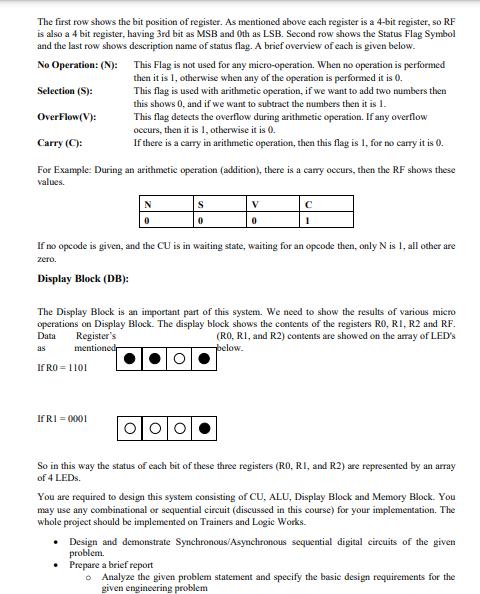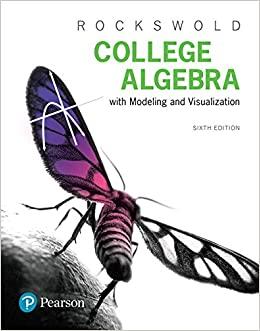Answered step by step
Verified Expert Solution
Question
1 Approved Answer
You have to design Mini Computational Unit (MCU) that performs following operations. 1. Transfer: that transfers binary data from one register to other that
You have to design Mini Computational Unit (MCU) that performs following operations. 1. Transfer: that transfers binary data from one register to other that shifts data in registers 2. Shift: 3. Arithmetic: That performs arithmetic operations on data in registers. All the Micro-operations mentioned above are performed using registers. So in our design we have to include some registers, let's say this memory block as Register Bank (RB) along with control signals that are controlled by a Control Unit (CU). And for the display of the results we need to have a Display Block (DB). So the high-level diagram of a system that can perform above mentioned operations would be like below. RB- 6 bit opcode 4 bit data CU DB Opcode: Each Micro-operation requires a unique opcode so that the CU can perform the desired operation. The opcodes of each micro-operation are given below: Micro-operation Transfer Shift Arithmetic ALU Opcode 00XXXX 11XXXX 01XXXX First bits from MSB identifies the tration. E.g., if the given input for opcode is 000000, then it shows transfer operation has to be performed. The micro-operations have many sub-operations. The sub- operations of each, with opcodes are as follows. Sr. No 11 2 3 4 15 Sr. No 1 2 Sub- operation Load Load Load Move Move Sr. No 1 2 Sub-operation Shift Left Shift Right Source User User User R2 R1 Addition Subtraction When the source is User (U), it means we have to provide data on input, so that it can be loaded into the specified register. The data should be loaded in Parallel. The Shift micro-operations are as follows: Shift (11XXXX) Source R2 R1 Sub-operation Source R0, R2 RI, RO Transfer (00XXXX) Designation Symbol R1 R2 RO RI R2 Bit position 3 Status Flag N The Sub-operations of Arithmetic micro-operation is as follows: Arithmetic (01XXXX) Designation Description R1 R2 Designation Symbol R2 R1 R1-U R2-U RO-U R1+R2 R2-RI No Operation R2 sl R2 R1-st R1 2 S Symbol R1 - R2+RO R2-R0+ R1'+1 Registers (RB): For sake of simplicity, the operations are performed with the registers mentioned as source and designation for each operation. We need four registers namely R0, R1, R2 and RF (Flag register). Each register is of 4 bits. R0, R1 and R2 are Data Registers. These registers contains data that is provided by the user. RF (Flag register) is a Status Register and is used to show the status of various micro operations. The Format of status shown by each bit of Flag register is as follows 1 V 0 Opcode C 000000 000001 000100 000010 000011 Selection Overflow Carry Opcode 110000 110011 Opcode 010000 010011 The first row shows the bit position of register. As mentioned above each register is a 4-bit register, so RF is also a 4 bit register, having 3rd bit as MSB and 0th as LSB. Second row shows the Status Flag Symbol and the last row shows description name of status flag. A brief overview of each is given below. No Operation: (N): Selection (S): OverFlow (V): This Flag is not used for any micro-operation. When no operation is performed then it is 1, otherwise when any of the operation is performed it is 0. This flag is used with arithmetic operation, if we want to add two numbers then this shows 0, and if we want to subtract the numbers then it is 1. Carry (C): For Example: During an arithmetic operation (addition), there is a carry occurs, then the RF shows these values. This flag detects the overflow during arithmetic operation. If any overflow occurs, then it is 1, otherwise it is 0. If there is a carry in arithmetic operation, then this flag is 1, for no carry it is 0. If R0=1101 IfRI=0001 N 0 S 0 V 0 If no opcode is given, and the CU is in waiting state, waiting for an opcode then, only N is 1, all other are zero. Display Block (DB): 1 The Display Block is an important part of this system. We need to show the results of various micro operations on Display Block. The display block shows the contents of the registers RO, R1, R2 and RF. Data Register's (RO, RI, and R2) contents are showed on the array of LED's below. as mentioned So in this way the status of each bit of these three registers (RO, RI, and R2) are represented by an array of 4 LEDs. You are required to design this system consisting of CU, ALU, Display Block and Memory Block. You may use any combinational or sequential circuit (discussed in this course) for your implementation. The whole project should be implemented on Trainers and Logic Works. Design and demonstrate Synchronous/Asynchronous sequential digital circuits of the given problem. Prepare a brief report o Analyze the given problem statement and specify the basic design requirements for the given engineering problem
Step by Step Solution
★★★★★
3.43 Rating (153 Votes )
There are 3 Steps involved in it
Step: 1
To design the Mini Computational Unit MCU as per the given requirements we need to specify the basic design requirements and then outline the components and their functionalities Here are the basic de...
Get Instant Access to Expert-Tailored Solutions
See step-by-step solutions with expert insights and AI powered tools for academic success
Step: 2

Step: 3

Ace Your Homework with AI
Get the answers you need in no time with our AI-driven, step-by-step assistance
Get Started





